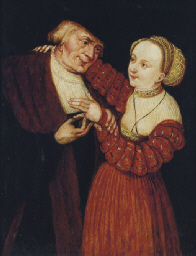Manner of Lucas Cranach the Elder PORTRAITS OF MARTIN LUTHER (1483–1546) AND HIS WIFE, KATHARINA VON BORA (1499–1552) both bearing the artist's device of a winged serpent, upper left and upper right, respectively a pair, both oil on panel In 1525 Martin Luther, an Augustinian monk, married Katharina von Bora, a former nun. Katharina von Bora had spent her life in cloisters since the age of five, but in her early twenties she became interested in the growing reform movement and applied directly to Luther. On 4 April 1523 Luther dispatched Leonhard Köppe, who regularly delivered herring to Katharina's monastery in Nimbschen, and she and several other nuns fled in secrecy to Wittenberg, hiding among the fish barrels in Köppe's wagon. Luther arranged homes, marriages and employment for the former nuns. Katharina spent time living with Lucas Cranach the Elder and his wife Barbara, and had many suitors, but she appears always to have intended to marry Luther himself. The marriage itself was witnessed by a small number of close friends – including Cranach and Barbara – but shortly afterwards a prolific pictorial propaganda campaign was set in motion, declaring the couple's union and by extension Luther's argument against clerical celibacy. Cranach was the principal portraitist of the couple and produced a number of pendants of the pair throughout their lives. His earliest likenesses, produced from 1525 – such as those in the Nationalmuseum, Stockholm – show a bare-headed, youthful Luther. 1 The present copies repeat the second type of portraits, which Cranach first produced in 1528. In these, although Katharina remains unchanged, Luther seems to have put on weight and is depicted wearing the black robe and beret of the Protestant clergy. Several autograph versions of this second type exist, such as those in the Hessisches Landesmuseum, Darmstadt, 2 in the Uffizi, Florence, 3 and in the Stiftung Schloss Friedenstein, Gotha. 4 1 http://lucascranach.org/SE_NMS_5016 2 http://lucascranach.org/DE_HLMD_GK73a and http://lucascranach.org/DE_HLMD_GK73b 3 http://lucascranach.org/IT_GdU_1160 and http://lucascranach.org/IT_GdU_1139 4 http://lucascranach.org/DE_SMG_SG18 and http://lucascranach.org/DE_SMG_SG17 Quantity: 2 Each unframed: 35.8 x 24.6 cm.; 14 1/8 x 9 5/8 in. Each framed: 47.2 x 35.7 cm.; 18 5/8 x 14 1/8 in.
Manner of Lucas Cranach the Elder PORTRAITS OF MARTIN LUTHER (1483–1546) AND HIS WIFE, KATHARINA VON BORA (1499–1552) both bearing the artist's device of a winged serpent, upper left and upper right, respectively a pair, both oil on panel In 1525 Martin Luther, an Augustinian monk, married Katharina von Bora, a former nun. Katharina von Bora had spent her life in cloisters since the age of five, but in her early twenties she became interested in the growing reform movement and applied directly to Luther. On 4 April 1523 Luther dispatched Leonhard Köppe, who regularly delivered herring to Katharina's monastery in Nimbschen, and she and several other nuns fled in secrecy to Wittenberg, hiding among the fish barrels in Köppe's wagon. Luther arranged homes, marriages and employment for the former nuns. Katharina spent time living with Lucas Cranach the Elder and his wife Barbara, and had many suitors, but she appears always to have intended to marry Luther himself. The marriage itself was witnessed by a small number of close friends – including Cranach and Barbara – but shortly afterwards a prolific pictorial propaganda campaign was set in motion, declaring the couple's union and by extension Luther's argument against clerical celibacy. Cranach was the principal portraitist of the couple and produced a number of pendants of the pair throughout their lives. His earliest likenesses, produced from 1525 – such as those in the Nationalmuseum, Stockholm – show a bare-headed, youthful Luther. 1 The present copies repeat the second type of portraits, which Cranach first produced in 1528. In these, although Katharina remains unchanged, Luther seems to have put on weight and is depicted wearing the black robe and beret of the Protestant clergy. Several autograph versions of this second type exist, such as those in the Hessisches Landesmuseum, Darmstadt, 2 in the Uffizi, Florence, 3 and in the Stiftung Schloss Friedenstein, Gotha. 4 1 http://lucascranach.org/SE_NMS_5016 2 http://lucascranach.org/DE_HLMD_GK73a and http://lucascranach.org/DE_HLMD_GK73b 3 http://lucascranach.org/IT_GdU_1160 and http://lucascranach.org/IT_GdU_1139 4 http://lucascranach.org/DE_SMG_SG18 and http://lucascranach.org/DE_SMG_SG17 Quantity: 2 Each unframed: 35.8 x 24.6 cm.; 14 1/8 x 9 5/8 in. Each framed: 47.2 x 35.7 cm.; 18 5/8 x 14 1/8 in.
.jpg)
.jpg)








Testen Sie LotSearch und seine Premium-Features 7 Tage - ohne Kosten!
Lassen Sie sich automatisch über neue Objekte in kommenden Auktionen benachrichtigen.
Suchauftrag anlegen